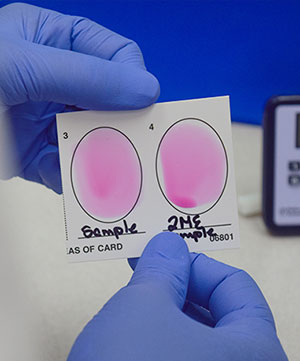Brucella testing: What’s the Best Test?
David Baum DVM, Katie Woodard DVM, Jeff Zimmerman DVM, Luis Gimenez-Lirola PhD, Sheila Heinen BS.
Iowa State University Veterinary Diagnostic Laboratory
The subject of “Best Test” remains popular among all who breed dogs or move animals across State or international borders. As long as there are options available (https://vetmed.iastate.edu/vdl/diagnostic-tests/ ), the question will always remain. One thing for you to remember: Brucella testing is a serial testing process. A serial testing process starts with a screening test followed by a confirmatory test of all non-negative samples. Recall, the purpose of a screening test is to detect ANY potential positive animal. This means there WILL BE nonspecific reactors, which require a confirmatory test. The confirmatory test is part of serial testing and interpretation. Serial testing improves diagnostic specificity and positive predictive value of a test process and asks the animal to “prove” it is affected by the condition being tested (1).
Moving animals across State borders. First, find out which test, if any, is required for entry of the species-type into the State of destination. If only a negative Brucella test result is required, we recommend the Brucella abortus/suis Buffered Acidified Plate Antigen (BAPA) Screen, offered each day of the week. This test, while relatively more sensitive than other tests, is lacking in specificity and are prone to subjectivity and variation between individual technicians. We promptly confirm non-negative samples with the Brucella Fluorescence Polarization Assay (FPA) with its results available by the end of the day. The test is simple to perform, rapid, highly reproducible across laboratories and instruments, and reduces the human error and variability that occurs when reading agglutination tests such as the card test. A negative FPA result is the official status (2) of the sample for the species listed in Table 1. Results are available by day’s end.
Table 1. Summary of B. abortus/suis BAPA Screen Test.
| Test Name | Species | Days Tested | Purpose of Test |
|---|---|---|---|
| B. abortus/suis BAPA Screen | Bovine, Canine, Caprine, Cervidae, Equine, Ovine, Porcine, Ungulate | MTWTF | Screen |
| Brucella FPA | Bovine, porcine | MTWTF | Confirmatory |
In the event the confirmatory Brucella FPA result is non-negative, the ISU VDL forwards the sample to National Veterinary Services Laboratory (NVSL) for confirmatory testing. NVSL sends their test results to the area-veterinarian-in-charge, the USDA Brucella epidemiologist, veterinarian of the State of origin, and to the ISU VDL. ISU VDL reports only the result of the NVSL confirmatory tests. The Brucella epidemiologist issues the official interpretation of the results.
Brucella canis. This is a significant reproductive disease agent of dogs, an intracellular bacterium and often found in breeding kennels throughout the United States (3). While generally thought of as an organism that produces abortions, the clinical signs of B. canis infection are varied and can be misinterpreted (3). Thus, it is possible for infected animals to raise infected puppies that can enter consumer markets (3). Routine whole-kennel screening helps kennel owners and veterinarians detect antibody against, and therefore infection from, B. canis. Any one of several tests detect B. canis antibodies. The essence of diagnosis is time, not in a test result alone (4). Time and retesting become the diagnostician’s allies. The ISU VDL offers one test platform for B. canis antibody testing: B. canis rapid slide agglutination test (RSAT). The RSAT a screening test, designed to detect any likely positive samples. The test has a high rate of false positives, so dogs which test positive are tested with 2-mercaptoethanol (2-ME) also called as 2-ME-RSAT. This disassociates nonspecific IgM and improves test specificity; where diagnostic sensitivity may decrease. Recall Hunky and Dory (Table 2) from last year’s April 2018 IVMA Update (4). An interpretation is suspect if a positive result on the RSAT screen and a negative result on the 2-ME-RSAT. Now, time and retesting become our allies. Based upon regulatory officials’ assessment who may quarantine the facility and/or animal(s) put into isolation.
Table 2. Brucella canis test reaction(s) and “Interpretation” of the results. The 2-ME-RSAT is performed on Dory’s serum sample after it has been treated with 2-mercaptoethanol (2-ME). “Result” is the outcome of the agglutination reaction on the slide: “Neg”, no agglutination observed; “Pos”, when agglutination observed. “Interpretation” is given only after 2-ME-RSAT results are recorded.
| Animal Id | Specimen | Test Name | Result | Interpretation |
|---|---|---|---|---|
| Hunky | Serum | B. Canis RSAT | Neg | |
| Dory | Serum | B. Canis RSAT | Pos | |
| Dory | Serum | B canis 2-ME-RSAT | Neg | Sus |
There are two possible outcomes following 2-ME-RSAT. One is “RSAT – positive and 2-ME RSAT – positive” which means the dog has circulating antibody, is likely infected and interpreted as ‘positive’ (“Pos”). The other possible outcome is “RSAT – positive and 2-ME-RSAT – negative” which means there may be cross-reactivity with another gram-negative bacterium or the dog is early in the course of infection. This combination of results is interpreted as ‘suspect’ (“Sus”). Resampling and retesting should occur 4-6 weeks later and include all animals with a “Suspect” initial test PLUS all animals with a “Negative”. This builds a clearer medical understanding of the involved animals, especially to determine if the suspect dog is early in the course of infection.
Please visit the ISU VDL website for the references, below.
- Thrusfield, M., Diagnostic testing, in Veterinary Epidemiology. 1995, Blackwell Science. p. 280. Sifford, R., Procedures for Handling Swine Herds with Brucellosis or Pseudorabies, USDA-APHIS-VS, Editor. 2018.
- Bramlage, D., W. Fortney, R. Kesler, C. Marbray, J. Mason, H. Reinhold, R. Sessions, and A. Wise, Best Practices for Brucella canis Prevention and Control in Dog Breeding Facilities, USDA-APHIS, Editor. 2015: Kansas City, MO.
- Baum, D., L. Giménez-Lirola, V. Cooper, J. Zimmerman, D. Schmitt, and J. Kaisand, Serology fundamentals, results, interpretations and B. canis antibody testing, in IVMA Update. 2018, IVMA: Ankeny, IA. p. 12.
